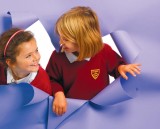Preconceptions about what they can and can't do prevent children from making progress...
What do you want? Depending on the tone of voice and where the emphasis is in the question, these four words can mean a multitude of things. For example, ‘Why are you interruptingme?’ Or ‘Not you again!’ Or perhaps it’s a more casual enquiry, like whether a colleague in the staffroom would like a cup of tea or coffee?
For us, this question marks the beginning of a journey; it’s the invitation we suggest a coach offers a coachee to share his or her preferred destination, something he or she wants to achieve. The coach’s tone would be one of interest, his attention focused solely on the coachee, and this simple, non-directive,open question would be the first step to a coachee realising how resourceful she can be in plotting their her course. But there might be a reason why she hasn’t embarked on this journey already.
Coach: So, what has stopped you so far from doing this?
Coachee: Well, I’m not very good at…
 The coachee believes her reply to be the truth, a cast in stone, unquestionable fact – just as it was once considered a ‘fact’ that the Earth was flat. However, when such beliefs are questioned and tested against an action plan to overcome them, many travellers find they can continue unhindered on their journey. A coach will help a coachee look again at the map and find that way forward.
The coachee believes her reply to be the truth, a cast in stone, unquestionable fact – just as it was once considered a ‘fact’ that the Earth was flat. However, when such beliefs are questioned and tested against an action plan to overcome them, many travellers find they can continue unhindered on their journey. A coach will help a coachee look again at the map and find that way forward.
There are several ways in which you can raise the children’s awareness about the existence of beliefs that block paths, how these can be formed, are often accepted without question, and how they can be overcome
Blocking beliefs can often be identified by the use of such words as can’t, never, always, every (one / body), need to, should, and so on. For example, “I never get the right answer!” or “I should be quiet until I’m spoken to.” Have the children noticed anyone using these words in this way? When and about what? Discuss their responses and provide examples of others they might hear. Ask them to keep notes of any additional instances they encounter over the next few days. When they have collected these they might think of how they could raise the individual’s awareness of the block and move them on. E.g:
| Suggested Responses | Collected Responses |
|---|---|
| “I never get the right answer!” | Tell me a time when you did get the right answer. |
| “I should be quiet until I’m spoken to” |
Who told you that? What do you think he meant? What would you like to do? |
| “She’s always picked to help!” | Always? Can you think of a time when she wasn’t picked? Can you be more specific? |
| ”“I can’t draw.” | What do you mean by you ‘can’t draw’? How might you improve in that area? |
The learning can be directly applied to coaching sessions. The same is true of the following activity.
Ask everyone to complete the sentence, “I’m good at…” They should think broadly here; it could be an activity, an area of the curriculum, a quality, etc. It would also be useful for them to think about what helps them to be good at the example in question. When they have decided, they can also write one for their partner (as a gift to them). In turns, they now ask the following sequence of questions: “What do you want?” and then, “What’s stopping you?” As mentioned above, the answer will most likely be a blocking belief. If so, the third question should then be, “How can your strength(s) help you?” This is a reference to the “I’m good at…” statement; and notice that the question presupposes that it can help, if not directly then as a result of thinking about it. Try it.
Shift children’s perceptions
What we believe can affect our behaviour, so if you believe the world is a scary place, then you may behave in a timid way; if you believe the world is an exciting place, you may spring out of bed every morning ready for your next adventure. Same world, different beliefs. Raise awareness and shift perceptions with these activities.
A. Describe a character to the children from a story you are all about to read. Ask them to predict how he or she might behave in certain given circumstances. Why do they think this?
B. Ask children to live by a motto for a day. So, if they choose to ‘approach every new experience as an adventure’, they should welcome such events positively and look for the enjoyment in them. ‘Treat others as you expect to be treated’ would be a useful one to develop a discussion around first.
C. Another day-long activity is connected to being aware of thoughts and possible beliefs forming. Every time a negative assumption starts to form in their minds, children should counter it with, “Well, maybe, maybe not.” In other words, rather than worrying that the black clouds may bring rain, which may mean outdoor PE is cancelled, which may mean that it will be extra reading time because the hall is being used, which may mean… Well, maybe, maybe not. Let’s see whether it rains first.
Just as we form beliefs about ourselves that affect our behaviour in positive and negative ways, we do the same with others. This also affects our behaviour – towards them this time – which can also impact on their beliefs about themselves and so their behaviours. Here are some awareness-raising ideas:
Using photos
Give each group a number of photos of people they have never seen before. Provide them with several ‘speech bubble’ cards for them to place against the people. Speech bubbles could include “I’m a singer in a rock band,” “I’ve been to prison,” “I have a house in London and one in the Bahamas”, “I’m unemployed,” and “I’m the personal assistant to a famous business person.” Ask children to explain to another group how they made their decisions. Extend this by asking them to create some more information about that person. This is a good exercise for discussing stereotyping and beliefs they may not know they hold.
Using newspaper articles
Provide two newspaper articles from different viewpoints on the same event and ask the class to identify what each newspaper wants you to think about the subject. How do they know (great for delving into the language of persuasion)? How might this affect people’s beliefs about that individual / group / organisation? What information would they need to help them form a more accurate picture? Conversely, what do we know about a specific famous person? What do we think we know? What questions would we need to ask to find out more?
Using discussion
 Take a universal but vague quality, like ‘kindness.’ Ask the class what it is to be kind. Can they define it and give some examples of people and of acts of kindness? Provoke more discussion by doing a ‘kindness scale’: who is kinder, the rich person who gives millions to charity, or the person who gives their old clothes to charity, or the Encourage risk-taking by trying out new ideas or ways of working. Discuss with the class what it is to ‘make a mistake’, how it helps them get closer to an answer or a preferred outcome. Provide examples of people making discoveries, inventing and pushing boundaries. How did mistakes help them? person who gives a warm drink to a beggar, etc. This will help them explore their ideas behind labels.
Take a universal but vague quality, like ‘kindness.’ Ask the class what it is to be kind. Can they define it and give some examples of people and of acts of kindness? Provoke more discussion by doing a ‘kindness scale’: who is kinder, the rich person who gives millions to charity, or the person who gives their old clothes to charity, or the Encourage risk-taking by trying out new ideas or ways of working. Discuss with the class what it is to ‘make a mistake’, how it helps them get closer to an answer or a preferred outcome. Provide examples of people making discoveries, inventing and pushing boundaries. How did mistakes help them? person who gives a warm drink to a beggar, etc. This will help them explore their ideas behind labels.
Challenging beliefs bring us right back to being nosey and questioning, the foundations of creative coaching. Noticing, questioning and thinking about why we think in one way and not another, and do or don’t behave in a particular manner in certain circumstances will help us understand ourselves better. Developing the creative attitude means that we develop a more positive and resourceful approach to life, whilst the coaching aspect takes that and applies it to helping individuals find their own ways to move forward. Helping children remove the blocking beliefs that hinder progress is one of several ways that creative coaching can help them get to where they want to be.
Ideas in this article first appeared in Coaching Emotional Intelligence in the Classroom (2010) by Steve Bowkett and Simon Percival, published by David Fulton Books, who have given their kind permission for material to be reproduced. Steve and Simon offer ‘PeopleWyse’ workshops to children and training for teachers in creative coaching techniques.
Steve Bowkett is a full-time writer, storyteller, educational consultant and hypnotherapist. He is the author of fifty-five books including the Countdown to writing series for Routledge.
Simon Percival is a former teacher who as a qualified and experienced coach now runs his own practice helping individuals, including students, reach their personal and professional goals
How children react to a moral dilemma may be down to your teaching
Ace-Classroom-Support
Becoming a teaching school
Ace-Heads
